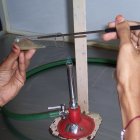Send to a friend
The details you provide on this page will not be used to send unsolicited email, and will not be sold to a 3rd party. See privacy policy.
A bottom-up approach is making locally-appropriate pesticides available to India’s poorer farmers, explains Daniel Puente-Rodríguez.
Developing appropriate pest-management products for resource-poor rural communities is easier said than done. But decentralising the scientific and production processes that go into biotechnology development can help. At the moment, biotechnology development is largely the preserve of formal, usually urban, scientists, and business-like research. Reorganising locally available human and natural resources could provide an answer.
Failing the poor
Despite India’s Green Revolution of the 1960s and 1970s, hunger and poverty are still endemic, especially in rural areas. The Green Revolution developed pest-management products, but in a linear way. Scientists conducted research, which agricultural extension workers translated into technologies, ready to be delivered on farmers’ fields. Agri-businesses still use this production model.
But while some improvements have been achieved, these production methods have largely failed to reach resource-poor farmers. For example, small-scale farmers are often unable to use agri-chemicals appropriately, and sometimes even become victims of their toxicity — either because they cannot read or do not understand the languages on the labels, or because they lack necessary protective equipment such as masks and gloves.
Rural India does have safe and efficient pest-management products available, for example, biopesticide sprays based onBt (Bacillus thuringiensis). But producing them usually requires technical expertise and capacity that rural areas don’t have. This makes production and distribution costly, so the sprays often become too expensive for resource-poor farmers, who still suffer huge losses from insect pests.
Going local
One answer could be to integrate the research and production process for biopesticides with locally available human and material resources.
A multi-stakeholder project in Andhra Pradesh is trying this approach. First, social scientists search for problems affecting the rural poor that could be tackled by biotechnology. Second, they identify research institutes capable of addressing such problems, and trusted NGOs (non-governmental organisations) that can work as intermediaries between farmers and scientists.

Working with Bt at a biotech centre in Andhra Pradesh, India
Daniel Puente-Rodríguez
In Andhra Pradesh, the Castor-semilooper pest causes major crop losses, but the new approach is fighting back. Scientists have identified Bt strains in local fields that are effective against the Castor-semilooper. This time, resource-poor farmers and NGO partners participated in field trials and feasibility tests.
The result has been a cost-effective and ‘low-tech’ solid state fermentation production process that can be reproduced on a small scale at the village level. Micro-enterprises have been created in some villages for producing and distributing the Bt spray. These biotech centres are run by local NGOs and technically supportedby research institutes. They provide employment for local youth as well as appropriate agrarian products. Other biopesticides and biofertilisers, adapted to local needs and capacities, are also manufactured.
Could and should large companies, with their technological capacities and economic power, enter these low-profit and resource-poor environments? Some companies have set up programmes to develop pro-poor technologies, but it has usually been done as a public relations exercise to improve the businesses’ image. Small-scale farmers often cannot affect up-stream research. Instead of participating in technology development, these farmers are frequently treated as passive recipients of the final products (as in Monsanto’s small-holder program in Andhra Pradesh).
Still, if local biotech centres, supported by networks of public research institutes and extension services, NGOs and farmers’ groups take root, we can expect agri-businesses to get involved, for better or worse.
One size does not fit all
The local approach is working in Andhra Pradesh largely because formal scientists are making space for NGOs and farmers within their research. To succeed, this sort of approach must be allowed to grow naturally — it can’t be planned or imposed by government because different improvisations and informal practices, specific to individual situations, are what makes it work.
So I’m not proposing the Andhra Pradesh example as a ‘one-size-fits-all’ model for redesigning biotechnologies. Yet something similar could be expanded to other rural poor regions of the world. The key to making this approach work is that development of biotech products must be rooted within (and have the consent of) the rural communities they are supposed to benefit.
Daniel Puente-Rodríguez is a PhD student in the Critical Technology Construction–Social Sciences Group at Wageningen University, and at the Athena Institute in the Faculty of Earth and Life Sciences at Vrije University, The Netherlands.
This opinion is based on an article published in Asian Biotechnology and Development Review ![]()
![]()
![]()













